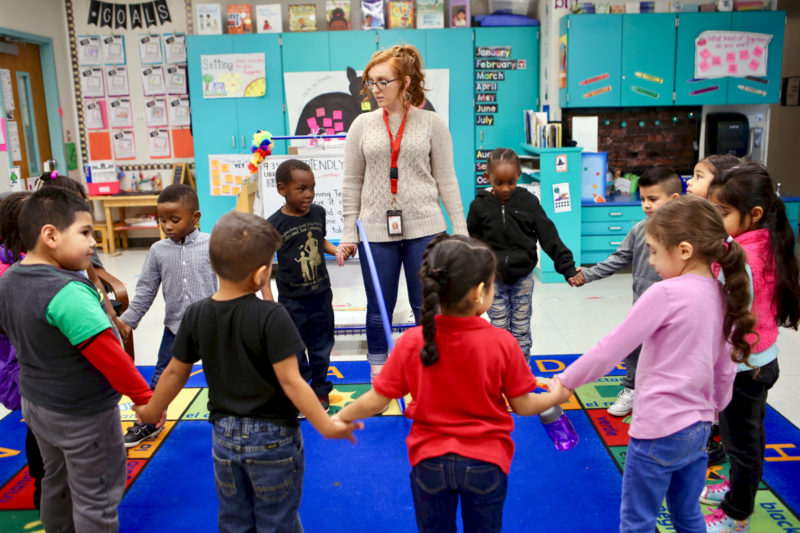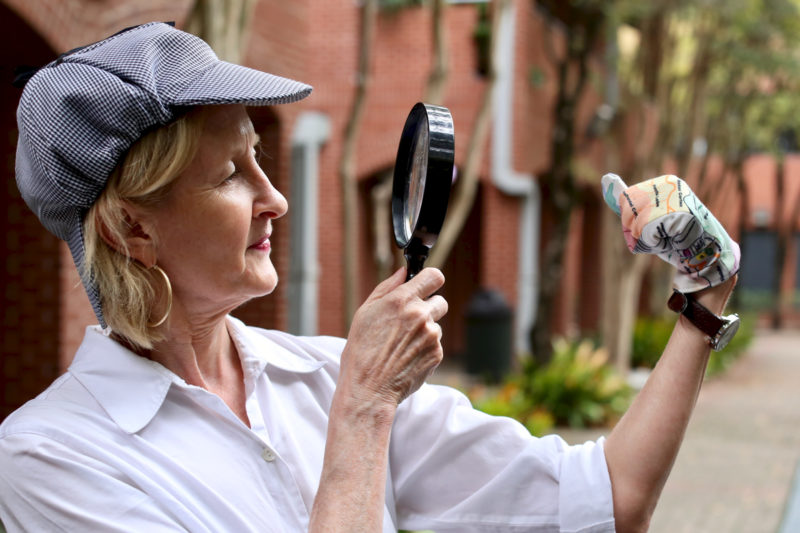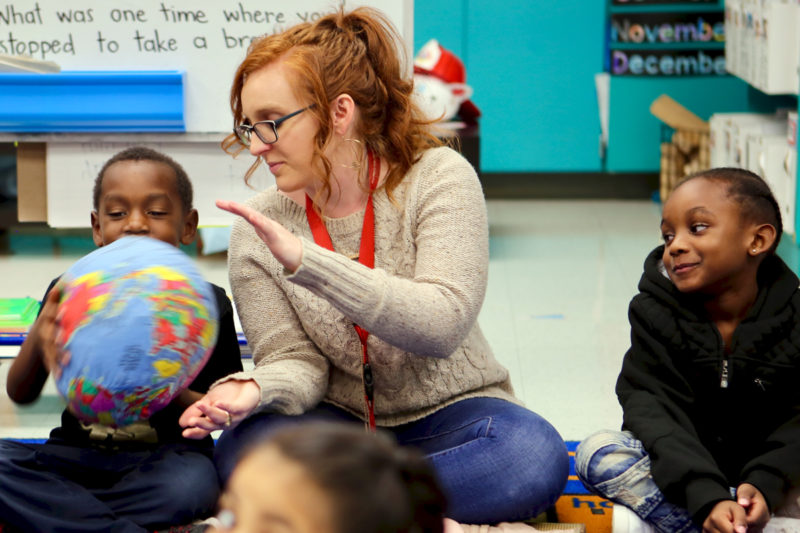Austin Schools Increase Focus on Social and Emotional Learning
By Vicky Camarillo
Reporting Texas

Austin teacher Elizabeth Wilson leads her class in a mindfulness exercise in November. Katherine Corley/Reporting Texas.
Clasping each other’s hands and standing in a circle, kindergartners at Austin’s Barbara Jordan Elementary School ducked their heads and clambered through a hula hoop that they passed around from student to student without breaking their grip. The 5- and 6-year-olds chanted each other’s names in encouragement and cheered as the hoop made its way around the circle.
On that morning in early November, as the commotion died down and the kids plopped themselves on a rug, teacher Elizabeth Wilson asked them how their bodies were feeling.
“Silly,” a girl wearing a bright purple jacket said.
“My body was feeling super silly,” Wilson said in agreement. “What’s something I can do so that my brain gets control of my body again?” she asked the students.
“You can take a deep breath,” a boy suggested.
That’s a great idea, Wilson said before leading the group in what she called a “team breath.” “One, two, three” — and the group inhaled and exhaled in unison.
The students were practicing mindfulness, one of the social and emotional learning practices the Austin Independent School District has started implementing in recent years.
During the last decade, teachers around the nation have increasingly focused on social and emotional learning to help students better manage emotions, maintain relationships and show empathy for others. In Austin, school district staff said these practices help children develop the skills they need to thrive in and out of school, and the district is aiming to be a leader in the implementation of social and emotional learning in the state.
“We can’t teach kids unless we are paying attention to where they’re at mentally and emotionally,” said James Butler, the district’s mindfulness specialist. “It feels weird that it’s a cool thing or a new thing when it should just be the thing.”
While mindfulness exercises are used throughout the district, it is experimenting with other social and emotional learning techniques, too.
This school year, teachers at five schools are employing the neurosequential model in education. Teri Wood, the district’s trust-based interventional coordinator, calls it a “mind shift” that incorporates brain science to help teachers understand student behavior and performance. Dawson, Becker, Pillow, Walnut Creek and Hill elementary schools are taking part in the pilot.

Teri Wood, Trust-Based Relational Intervention Coordinator for AISD, examines her “brain glove,” which is used to show students which parts of their brain activate during difficult emotional experiences. Katherine Corley/Reporting Texas.
A third technique, trust-based relational intervention, was initially created for parents who had adopted children with traumatic backgrounds and is used in all schools in the district. The goal is to look at students’ misbehavior not as a deliberate attempt to “make people miserable,” Wood said, but as a response to environmental stress. That could mean the behavior is an effect of trauma, or it may be a matter of meeting basic needs like food or sleep, Wood said.
Before Wood was trained in trust-based relational intervention last year, she’d worked in elementary counseling in the district for about 15 years. She and other district officials gradually started getting requests from teachers to be trained in the program. In February, the district put a limit on suspensions of prekindergarten through second-grade students, and as part of that effort, Wood said, about 4,000 staff members have been trained in trust-based relational intervention.
Wood said the district is still gathering data to measure the success of the social and emotional learning techniques, but teachers have given positive feedback.
At the district’s administrative offices on an overcast October morning, Wood explained the roles of various props used in social and emotional learning lessons. Among them: a colored paper plate, a shaken-up bottle of Coke and a Hoberman sphere — a colorful, spherical toy that expands and contracts.
Some of those items are used to identify emotions and energy levels, as in the case of an “engine check,” a paper plate with colored sections that denote energy levels (blue is low energy, red is frenetic and green is focused). When students are frustrated or hyperactive, teachers can work with them to find ways to ease the lid off the agitated Coke bottle so it doesn’t blow up. And teachers can use the Hoberman sphere, Wood said, to lead students in breathing exercises.
Wilson is among a growing group of teachers who have integrated circles in their classes to build a sense of community. When the class is in a circle, that’s their time to share a fun activity together and work on academic skills, but it’s also a chance for teachers to assess how students are feeling.
“Students feel like their needs are being met. They feel seen, and they feel heard,” Wood said. “Just the act of relating and connecting helps build positive brain connection.”
Wood referenced the Adverse Childhood Experiences Pyramid, which represents health and social problems that people are susceptible to if they have traumatic experiences as children. Those adverse effects begin with social, emotional and cognitive impairment and can escalate to early death.
“When we’re talking to teachers about this, we’re like, ‘Guys, we don’t want to leave you with doom and gloom, so let’s talk about resiliency,’” Wood said, adding that when children have adults in their lives who make them feel seen, they gain a sense of self-efficacy. “We have it in our capacity to make a difference as educators, because already, for a lot of kids, we’re that person.”
Wood’s work frequently overlaps with the mindfulness program created by Butler, a former Austin pre-K and kindergarten teacher who turned heads when he began practicing yoga, which he called mindfulness, with his students. He said his curriculum is used in one way or another at all 130 of the district’s campuses — not always in the form of stretching but sometimes, as in Wilson’s class, identifying emotions and interacting with each other.
Wilson, who graduated from the University of Texas at Austin in 2016, is in her third year of teaching. After her first year of navigating the emotional unpredictability of kindergartners, she sought support from the district to teach her students coping and problem-solving skills. Administrators connected her with Butler, who visited her class and led lessons with the kids.
“These kids are very capable of naming and recognizing emotions, and if we’re not teaching it now, then they never get that, unless it’s in a restorative way versus a preventative way,” Wilson said. “Not all of the behaviors that are traumatic are going to be represented in ways that are challenging. You’re going to have kids who are very quiet and shy, and those need to be addressed just as much as those throwing books across a room.”

Austin teacher Elizabeth Wilson leads her class in a mindfulness exercise in November. Katherine Corley/Reporting Texas.
Wood started receiving requests to train staff in other school districts after she gave a presentation about social and emotional learning for the American School Counselor Association earlier this year. Austin educators take pride in being ahead of the game, Butler said, but there is sometimes less focus on mental health awareness in rural areas.
In rural schools, teachers or parents may be skeptical about prioritizing mental health, Butler said. But if one teacher would give those practices a try, more would follow.
“I wish I could get across to all schools that this really does work with all kids, but it takes listening and hearing from someone who’s doing similar work to get them to buy in,” Butler said.
Parents seem to like the focus on emotional learning. In a districtwide survey done this year, 97 percent of parents said their child demonstrates social and emotional skills learned in school.
Kimberly Whalon said her son, Jayden LeBlanc, used to get easily frustrated by small things, such as not being able to find his shoes in the morning. Since he joined Wilson’s class, he stops, takes a deep breath and thinks about what he’s doing, she said.
“He really tries to empathize with people, and he never did before,” Whalon said. “He takes the time to make sure someone else is OK. Seeing it, I know that somebody’s teaching something outside of what he gets at home. He uses his words so much more to describe when he’s angry or upset.”
In Wilson’s class on that November day, she asked her students to give examples of good times to stop and take a deep breath. After recess, after being mad, after being frustrated by schoolwork, the kids said. One girl said she took a breath when she got scared at home. Wilson gasped theatrically.
“You took what you learned at school, and you did it at home?” she asked. “Does anybody else do that?” Several kids said yes.
“Smartest kindergartners ever,” Wilson said.